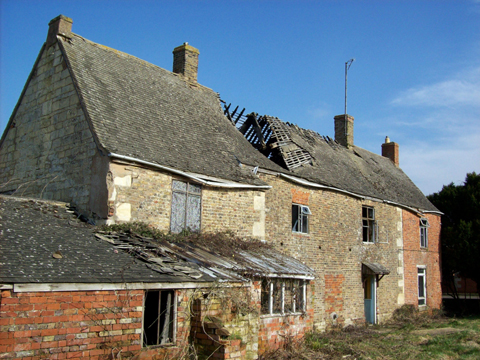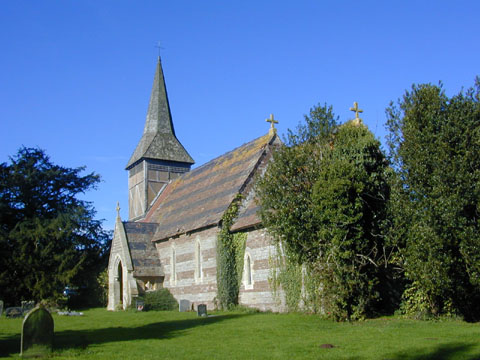SAVE's New Buildings at Risk Catalogue: Sample Entries
The above collection of images represent some of the entries in our new catalogue. To find out more or to view further entries please order the catalogue or consider subscribing to use our online register.
Slide 1: Juniper House, High Street, Stretham, Cambridgeshire - FOR SALE
Juniper House is a large, former 17th-century rectory situated alongside the 14th-century parish church in Stretham, a village ten miles north of Cambridge. The house is built in brick and clunch, the traditional construction material of the region, and was lightly converted to modern office use in recent years.
Juniper House was built during a prosperous period that followed the drainage of the surrounding fen in the 17th century. With increased land for cultivation, grazing and building, the village grew in size and wealth. Notable residents of Juniper House include Mark Ridley who became the physician to the Tsar of Russia, and Henry Hervey Baber, who became Keeper of Printed Books at the British Museum in 1812.
The house has been vacant for two years although structurally it does not appear to be in bad condition. It has 10 bedrooms and 7 reception rooms and a good sized garden. The adjoining timber-frame coach house is also up for sale and has excellent potential for conversion to residential use. This is a charming but generously sized historic house which, if sympathetically repaired, could make a wonderful home.
Slide 2: Central Hall Methodist Church, Fisher Street, Carlisle, Cumbria - TO LET/FOR SALE
The former Methodist Church occupies a prominent position on Fisher Street. It is an imposing red sandstone building of 1922 with crisp classical detailing. Inside it retains attractive decorative plasterwork interiors.
The building, recently listed Grade II, reflects the importance ofNonconformist worship within Carlisle in the early 20th century. The church was designed by Brocklehurst and Hornabrook and largely funded by the millionaire philanthropist, Joseph Rank (of Hovis fame). The remainder of the money was raised by the first minister of the church, the Revd Bramwell Evans, who later became a national icon as the voice of BBC Radio’s ‘Romany’ – the children’s nature programme that inspired the likes of David Attenborough and David Bellamy.
Inside the building there is an abundance of elaborate wood carving, decorative plasterwork and panelling. There is also an octagonal central hall with choir, rostrum and an organ facing the congregation, with a lantern overhead.
The Church only recently closed and the building is still in good order. However, no one has yet stepped forward to take on the hall and there have been no suitable suggestions for appropriate reuse. The main building is not open to subdivision but would be best used as a performance space or a community use which could make use of the existing seated areas.
Slide 3: Greenbank Prison, Greenbank Road, Plymouth, Devon
This granite and limestone building is in a pitiful state. Two wings of the prison, including the Governor’s house, were already demolished before the building was finally listed on the fourth attempt in 2008.
Plymouth Borough Gaol (as it was previously known) was opened in 1849. It was designed by the architects Fuller (also architect of the Newark works in Bath) and Gingell (who built a number of good buildings in Bristol in a similar Italianate style). Most adornment is on the main façade of the two-storey building which has a taller bell tower at its centre.
The prison closed for a short time in 1878 but then continued to function until 1935 when it was taken over as the Plymouth Police Headquarters. This involved considerable alterations to the buildings as well as the conversion of one wing into a magistrates’ court. The police stayed until 1976 when the Plymouth Health Authority took over. The site was finally vacated in the early 1990s and has remained empty ever since.
Both the supermarket Aldi, and developers Persimmon Homes have been mentioned in association with the site. Various schemes, all of which have been refused, so the former prison stands overgrown and derelict, with a collapsed roof and broken windows. A suitable scheme is desperately needed which will properly consider the architectural qualities of the building. This could possibly be a mixed-use scheme with residential space, offices, food and leisure facilities.
Slide 4: Brookside, Leonard Stanley, Gloucestershire - FOR SALE
Brookside (once painted by Stanley Spencer) was listed on the third attempt whilst threatened by demolition.
It has deteriorated badly since and been further damaged by fire and flooding. It is now partially open to the elements and is seriously at risk. The local community has fought hard to see Brookside saved and repaired. A new owner willing to invest in urgent repairs is now desperately needed.
Parts of the building date from the 17th century, possibly even earlier. The house has a two-room plan with a central cross-passage, with stacks at either end to accommodate fires on both sides of the house. Despite a fair amount of loss from alteration and fire, there is a significant amount of surviving early fabric.
New applications will be necessary to carry out any work on the building. Now that it is finally being marketed there is hope that Brookside could be restored as a charming home.
Slide 5: St Andrew’s Church, Wolferlow, Herefordshire
Parts of St Andrew’s date to the 12th century and despite substantial restoration in the 19th century (by F R Kempston) there are a number of surviving Norman features including the south doorway and tympanum, the blocked north doorway and the chancel arch.
The walls of the church are constructed from red and grey sandstone laid to produce a banded effect. At the west end a bell-turret with a pretty broach spire rests upon medieval timbers. Pevsner notes that inside the chancel is a late 13th-century stone effigy of a Lady.
The Grade II* listed church has closed and a hole in the roof has since developed. The predicted repair bill has alarmed the Diocese which is now marketing the attractive building. A church of this age and sensitivity will require some detailed thought and careful contemplation as to how it can be reused in the best and most sensitive manner. If it were to be suitably converted into a single residence it would certainly be hot property.
Wolferlow is a hamlet north of Bromyard in Herefordshire. The church has been seeking new owners for the building.
To read further entries ORDER THE CATALOGUE or subscribe to BECOME A FRIEND OF SAVE for access to our online register.





